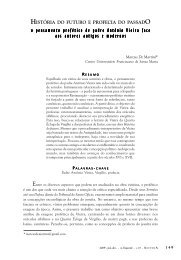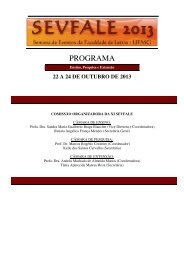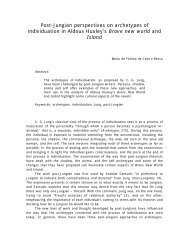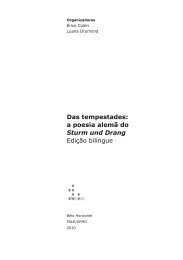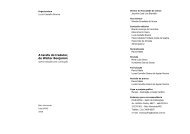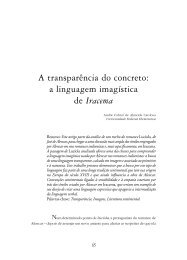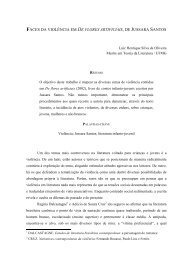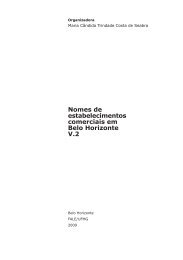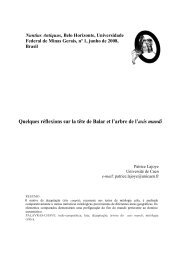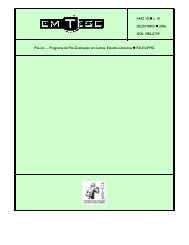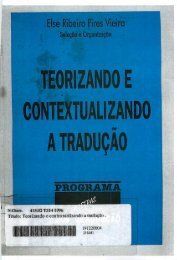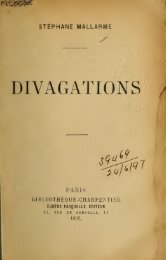E. E. Cummings: Modernist Painter and Poet
E. E. Cummings: Modernist Painter and Poet
E. E. Cummings: Modernist Painter and Poet
You also want an ePaper? Increase the reach of your titles
YUMPU automatically turns print PDFs into web optimized ePapers that Google loves.
spontaneity, of "happening" on<br />
the page, they result from the calculated<br />
placement of each mark:<br />
<strong>Cummings</strong> planned his spontaneity.3"<br />
In his painting after 1926,<br />
by contrast, <strong>Cummings</strong> usually<br />
pursued this spontaneity more directly<br />
through a kinetic technique,<br />
or, as he put it in one private<br />
note, "chunking ahead with a big<br />
brush held loosely & loaded with<br />
paint."35 The painting sea is one of<br />
the more successful examples of<br />
this style (see fig. 14).<br />
In virtually all respects, then,<br />
<strong>Cummings</strong>'s poetry was more<br />
complex <strong>and</strong> subtle than his<br />
painting. By responding to the<br />
slightest nuance of language <strong>and</strong><br />
intensifying such nuances with his<br />
visual imagination, he was able to<br />
manipulate <strong>and</strong> exploit words in<br />
more ways to effect more kinds<br />
<strong>and</strong> dimensions of meaningvisual,<br />
aural, semantic, <strong>and</strong> syntactic-than<br />
he could achieve<br />
through his painting. The "calculated<br />
spontaneity" of his poems,<br />
moreover, permitted a fine balance<br />
between thought <strong>and</strong> feeling,<br />
between the poem's disciplined<br />
construction <strong>and</strong> its visceral ap-<br />
Notes<br />
1 E. E. <strong>Cummings</strong> to Rebecca H.<br />
<strong>Cummings</strong>, 24 April 1919, Selected Letters<br />
ofE EE. <strong>Cummings</strong>, ed. F. W.<br />
Dupee <strong>and</strong> George Stade (New York:<br />
Harcourt Brace & World, 1969), p. 58.<br />
2 Although the term "defamiliarization"<br />
belongs to Russian Formalism,<br />
<strong>Cummings</strong>'s notes show that he pur-<br />
sued the same effect in his poetry<br />
through visual displacements in<br />
spacing <strong>and</strong> typography. See Milton A.<br />
Cohen, "E. E. <strong>Cummings</strong>' Sleight-of-<br />
H<strong>and</strong>: Perceptual Ambiguity in His<br />
Early <strong>Poet</strong>ry, Painting, <strong>and</strong> Career,"<br />
Universit, of Hartford Studies in Liter-<br />
ature 15, no. 1 (1983): 33-46.<br />
3 Isabel Lachaise, quoted in <strong>Cummings</strong><br />
to Rebecca <strong>Cummings</strong>, 7 April 1919,<br />
Selected Letters, ed. Dupee <strong>and</strong> Stade,<br />
72 Spring 1990<br />
pearance. His painting, by contrast,<br />
gravitated toward one or the other<br />
of these poles but seldom inte-<br />
grated them successfully. The cal-<br />
culated paintings, such as View<br />
from Joy Farm (see fig. 15), thus<br />
risked stodginess <strong>and</strong> convention-<br />
ality, while the "spontaneous"<br />
style could produce a muddle<br />
when it was not inspired.<br />
William Slater Brown was per-<br />
haps right to question from the<br />
outset <strong>Cummings</strong>'s dogged persis-<br />
tence in painting when words<br />
were clearly his medium.<br />
<strong>Cummings</strong> was a born writer, a<br />
self-made painter. Yet one cannot<br />
help but respect his perseverance<br />
as a painter who endured all<br />
manner of disappointments: bad<br />
reviews, indifference <strong>and</strong> igno-<br />
rance, misconceptions about his<br />
seriousness, <strong>and</strong>, potentially most<br />
crippling of all, self-doubts about<br />
his aims.36 <strong>Cummings</strong> weathered<br />
them all <strong>and</strong> continued painting to<br />
the day he died. Whatever their<br />
stutterings of facility, their lapses<br />
of critical judgment, his paintings<br />
bespeak an artist for whom the<br />
self-created identity of "poet <strong>and</strong><br />
painter" was indivisible.<br />
p. 58. For other references to Lachaise,<br />
see letters dated 1918-20, pp. 45-63.<br />
4 "Independents Run Gamut in Art<br />
Show," New York Sun, 30 March 1919,<br />
p. 14, col. 3. On <strong>Cummings</strong>'s gallery<br />
invitations, see <strong>Cummings</strong> to Rebecca<br />
<strong>Cummings</strong>, 7 April <strong>and</strong> 24 April 1919,<br />
Selected Letters, ed. Dupee <strong>and</strong> Stade,<br />
pp. 57-58. On his nomination to the<br />
board of directors of the Independent,<br />
see Richard S. Kennedy, Dreams in the<br />
Mirror: A Biography of E. E.<br />
<strong>Cummings</strong> (New York: Liveright,<br />
1980), p. 204.<br />
5 <strong>Cummings</strong>'s 1915 undergraduate com-<br />
mencement address, "The New Art,"<br />
reflects his familiarity with an impres-<br />
sive range of avant-garde artists, in-<br />
cluding Igor Stravinsky (1882-1971)



